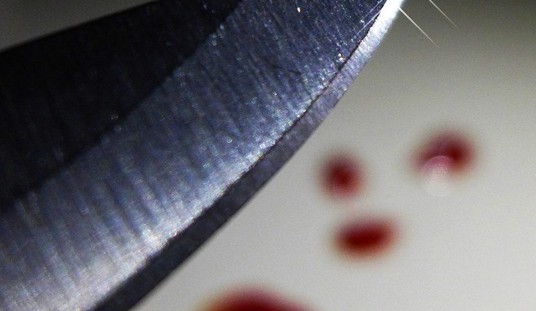Once cops started training on silhouette targets instead of bullseye targets they were taught to aim for “center of mass.” On most police silhouette targets (e.g., B-27) the center of the legless body’s mass, where one scores the highest points, is right around the stomach, in the upper abdomen. (In fact, the physical center of mass of the human body is located a few inches below the navel.) The rationale for this was most likely because a shot aimed at the visual center of mass has the greatest chance of staying on the legless silhouette if it strays from its point of aim. As time went by silhouette targets were developed which placed “center of mass” up in the chest, where the heart and the major vessels are located. Anatomically this makes more sense than shooting for the stomach but, as many hunters can attest, a large mammal may function for about 15 seconds after the heart is destroyed.
Many instructors advocate head shots, usually as a secondary aiming point. There are a few problems with head shots:
- The head is a very mobile target. It is instinctive to swing it away from a perceived threat, making it particularly difficult to hit in actual combat. Bill Lewinski, Executive Director of the Force Science Institute, has documented that an unrestrained subject can move his head sideways 6 to 10 inches in as little as 1/10th of a second – “faster than a rifle bullet can travel 200 yards and faster than any officer could possibly react.”
- While a shot anywhere in the head of a paper target looks pretty good, there’s a large amount of the head which does not include essential parts of the central nervous system (CNS). Most instructors with understanding of the CNS recommend aiming for the brainstem – a target about the size and shape of a man’s thumb.
- The essential parts of the central nervous system are encased in heavy bone. Bullets which meet the skull at less than a perpendicular angle may not penetrate it, particularly if they have a rounded surface in their profile. Thus, even if one has the skill to hit the correct area of the surface of the head under stress, the shot may still not accomplish its purpose.
Over four decades ago, for a few years, NYPD operated a Stakeout Unit. SOU Officers–usually in pairs–would take up hidden positions in businesses that were at high risk of armed robbery. Concerned that some of the robberies they would interrupt might involve more than two perpetrators, they asked Dr. Vincent Di Maio, NYC’s medical examiner at the time, where they could shoot a fleeing robber, to keep a gunfight from spilling over onto a crowded sidewalk. Di Maio told them to shoot into the pelvic area. Jim Cirillo–one of the few men who could consistently make head shots in the heat of a gunfight, albeit not necessarily penetrating the cranial vault every time–told me that every felon shot in the pelvic area by the Stakeout Unit fell to the ground.

When I was taught the option of shooting into the pelvis, I was led to believe that it was a fracture of the pelvis that dumped people to the ground. I subsequently learned that it is very difficult to obtain a complete fracture of a living pelvis with a single shot from a handgun. However, branching in the pelvis, to run down each leg, is a bundle of vein, artery and nerve. The most likely mechanism that drops to the ground someone who has been shot in the pelvis is the shock to that major nerve running into the leg – a phenomenon called neurapraxia. It’s also worth noting that a shot that actually strikes that neurovascular bundle and lacerates the artery will produce death in a very few minutes, absent surgical intervention. Again, each of those optimal targets in the lateral pelvis is also about the size of a man’s thumb. However, at the close distances of most handgun engagements, just dropping an assailant to the ground will stop an attack with a contact weapon, such as a knife, and will provide a few seconds in which to create distance or move to a more favorable angle, should additional shots be required.
In a 1998 training seminar, there was a module on shooting while moving laterally. There had been a classroom discussion about the anatomically incorrect location of the 10-ring on the B-27 targets that we would be using. The instructor also emphasized the fact that, on the street, our real target would be a few inches deeper that the surface of the paper, requiring effective shots to shift increasingly to the side to which we would be moving.
Still, when we hit the range, I watched a skilled female friend keep every shot inside the 10-ring. Ingrained habits are hard to break!
Nearly a decade later, at a similar training conference, I was fortunate to find that one of the keynote speakers was Dr. James Williams, who presented his Tactical Anatomy course. Williams teaches three aiming points: the upper heart and major vessels around it, the brainstem and the lateral pelvis. However, he emphasizes learning the three-dimensional locations of these structures or, to put in another way, using “X-ray vision” when you aim. If you can’t take one of these courses, at least do what many serious hunters do and develop on your own an anatomically correct, three-dimensional awareness of where you need to place your bullet.
In the last half of my teaching career – when I was free to teach courses of my own design – I used full-color photographic targets. Once we got past the arm’s length exercises, I used images that did not face the shooter squarely and some in which the optimal aiming point was not centered in the target frame. After each set of shots, I normally pointed out to my students what their shots would have hit inside a real human body if fired from the angle at which they had fired. As I said earlier, ingrained habits are hard to break and I’ve yet to meet anyone who’s been attacked by a buff-colored IPSC target.
(I do not have a Facebook account and cannot respond to comments here. If you have a serious question for me, a click on the link to my own website – in the author information, below – will offer you links that can be used to send me e-mail.)









Join the conversation as a VIP Member